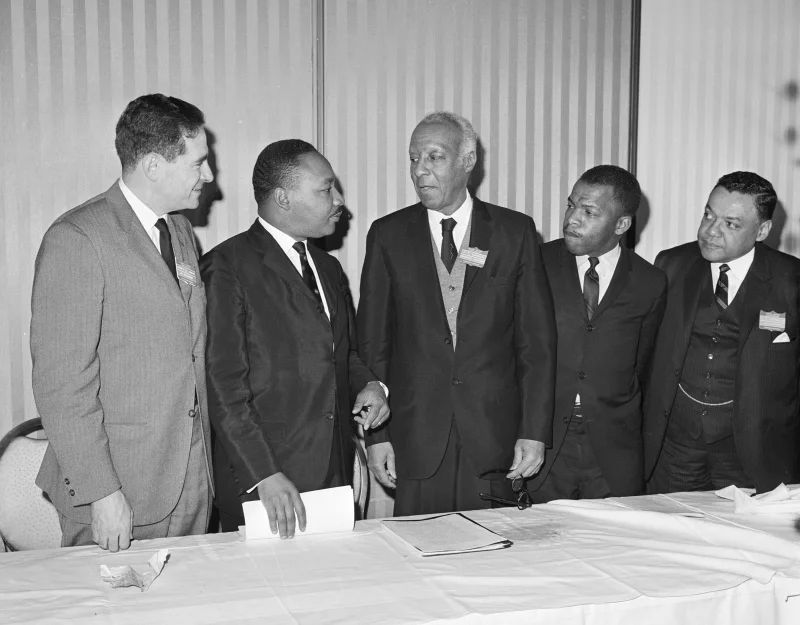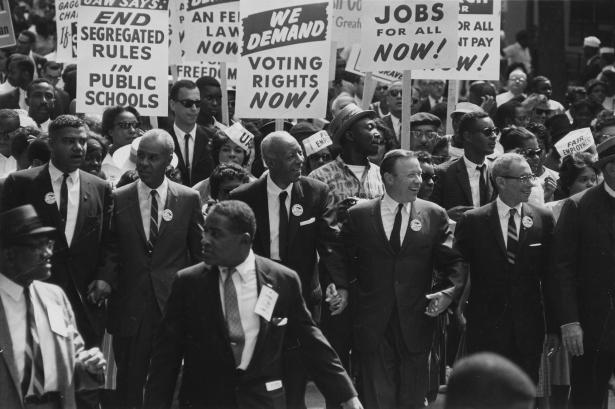The Supreme Court’s elimination of affirmative action is undeniably a setback for racial justice—one that will lead to a substantial decline in Black and perhaps Hispanic enrollments in universities and professional schools. It will lead as well to a narrowing of the pipeline that supplies much of the nation’s leadership. But it is also an opportunity—a moment to reconsider far more ambitious and effective strategies for achieving racial justice.
Affirmative action was never the true goal of the civil rights movement; the ultimate prize was full racial equality. At best a consolation prize, affirmative action was a modest concession granted by the Establishment in a time of turbulent racial upheaval. To be sure, the vast majority of civil rights leaders favored affirmative action: as Martin Luther King Jr wrote, “A society that has done something special against the Negro for hundreds of years must now do something special for him.” But the demands of the civil rights movement went far beyond affirmative action—a policy that was effective in altering the racial composition of the elite, but left the conditions of most African-Americans unchanged.
At the height of the civil rights movement, five organizations dominated the struggle for racial justice: Martin Luther King’s Southern Christian Leadership Conference (SCLC), the NAACP, the Congress of Racial Equality (CORE), the Urban League, and the Student Nonviolent Coordinating Committee (SNCC). Following the great legal victories of the movement—the passage of the Civil Rights Act of 1964 and the Voting Rights of 1965—the leaders of the Big Five came together to support an ambitious 1966 program, analogous to a domestic Marshall Plan, named A “Freedom Budget” for All Americans. Coauthored by A. Philip Randolph and Bayard Rustin, and supported by the presidents of key labor unions including the United Auto Workers and the United Steelworkers of America, prominent Protestant, Catholic, and Jewish leaders, and eminent intellectuals such as John Kenneth Galbraith, David Riesman, and Daniel Bell, it brought together a broad coalition in support of a plan calling for the total elimination of poverty by 1975.
But the Freedom Budget was far more than a plan to help the poor. Alongside its assault on poverty, it proposed a multi-pronged program, including full employment, a massive public housing initiative, expanded investment in education job training, a nationwide and universal system of health insurance, and a guaranteed minimum income for all Americans. Well aware that a program of this magnitude would disproportionately help black Americans who were concentrated in the lower runs of America’s social structure, the authors of the Freedom Budget emphasized that a clear majority of America’s poor and unemployed were white. In his introduction to a summary version of the Freedom Budget, A. Philip Randolph, the great elder statesman of the civil rights movement who had inspired the 1963 March on Washington, wrote of “the tragedy…that the workings of our economy so often pitted the white poor and the black poor against each other at the bottom of society.” Only a coalition bringing together all races, argued Randolph and Martin Luther King, who wrote the Foreword to A Freedom Budget for All Americans, could generate the political pressure necessary to make the Freedom Budget a reality.
The Freedom Budget marked the next stage of the civil rights movement; having won civil and political rights, the movement was now demanding social and economic rights. Had it been adopted, the Freedom Budget would have moved the United States several steps towards a Scandinavian-type social welfare state; in so doing, it would have massively improved the life conditions of not only black Americans, but poor and working-class Americans of all races. But, the Freedom Budget was expensive; costing 185 billion dollars over ten years (the equivalent of over 1.7 trillion dollars today), it fell victim to both the escalating cost of the war in Vietnam, where nearly 400,000 American troops were stationed by the end of 1966, and a rising white backlash.

From left, Morris B. Abram, Rev. Martin Luther King, Jr., A. Philip Randolph, John Lewis and William T. Coleman take part the White House Conference on Civil Rights with a call for $100 billion "Freedom Budget". Bettmann Archive/Getty Images
The Freedom Budget was by no means the only African-American voice calling for fundamental change. In the same month that the Freedom Budget was published, the newly formed Black Panther Party issued its “Ten-Point Program.” Far more radical than the Big Five civil rights organizations, the Panthers demanded reparations in the form of currency reflecting the “overdue debt of forty acres and a mule,” an “immediate end to police brutality and the murder of black people,” that “all black men…be exempt from military service,” “freedom for all black men held in federal, state, county, and city prisons and jails,” and “land, bread, housing, education, clothing, justice and peace.” Taken together, the demands of the Panther Party platform constituted a call for an end to capitalism and the initiation of a vaguely defined revolution.
In the wake of the violent racial rebellion in Newark, Detroit and other cities in the summer of 1967, even Establishment voices issued calls for drastic change. On July 28, 1967, while Detroit was still in flames, President Johnson formed the National Advisory Commission on Civil Disorder (later widely known as the Kerner Commission) to understand the cause of the riots that had shaken American cities and to suggest policies that would prevent such riots from occurring in the future. But The Kerner Report was not what President Johnson had expected. Reflecting the sense of crisis then gripping the nation, the report declared, in a passage that has echoed through time, that “what White Americans have never fully understood—but what the Negro can never forget—is that white society is deeply implicated in the ghetto. White institutions created it, white institutions maintained it, and white society condones it.”
For an Establishment panel, the Kerner Commission’s recommendations were surprisingly bold: the creation of two million jobs, the establishment of “uniform national standards of assistance at least as high as the single ‘poverty level’ of income,” bringing “six million new and existing units of decent housing within the reach of low and moderate income families within the next five years,” and a transformation in the organization and functioning of policing. Like the Freedom Budget, the cost of the programs proposed by the Kerner Commission would run into the tens of billions of dollars. And like the Freedom Budget, after an initial wave of enthusiasm (selling three quarters of a million copies in the first two weeks alone), the escalating cost of the Vietnam War and a rising racial backlash would mean that the Commission’s ambitious proposals would never be implemented.
Martin Luther King Jr praised the Kerner Commission Report when it was released on March 1, 1968, calling it “a physician’s warning of approaching death, with a prescription for life.” At the time the Kerner Report was published, however, King was deeply absorbed in planning his Poor People’s Campaign—an effort to bring poor people of all races together in an effort at mass mobilization, using civil disobedience if necessary. The Poor People’s Campaign, as King envisioned it, would culminate in a giant and sustained demonstration in Washington DC, demanding that the nation’s politicians finally act to end the scandal of poverty in the world’s richest nation. Over the past several years, King had become increasingly militant, telling journalist David Halberstam that “after laboring with the idea of reforming the existing institutions of the society, a little change here, a little change there,” he had come to believe that what was needed was a “reconstruction of the entire society.” At a staff retreat of the SCLC, King went even further, privately telling those present that it was time to disrupt business as usual in “earthquake proportions,” that “something is wrong…with capitalism” and that “America must move towards a democratic socialism.” But on April 7, 1968, King’s plans for the Poor People’s Campaign—and any elaboration of his increasingly radical worldview—came to a tragic end with his assassination in Memphis.
More than half a century later, what is striking about revisiting the aspirations of the 1960s civil rights movement is how peripheral affirmative action was to its deepest aspirations. In place for two generations, affirmative action has undeniably produced considerable achievements: the diversification of the nation’s leading colleges and universities, the massive expansion of the black middle class, and the creation of a leadership stratum more representative of the American people. One should not, however, exaggerate the magnitude of the changes it produced. As Richard L. Zweigenhaft and G. William Domhoff, who have written several influential books on diversity in the American elite, observe, minorities selected into the elite “share the prevailing perspectives and values of those already in power.” Their ethos “is not ‘multicultural’ in any full sense of the concept, but only in terms of ethnic or racial origins.”
Yet however one judges the ultimate impact of affirmative action, it is now a policy of the past. For those who remain committed to the cause of racial equality, the ideas of the mainstream of the civil rights movement of the 1960s—among them, a concerted assault on poverty, the adoption of a nationwide guaranteed income, universal healthcare, the creation of the European-style welfare state, and the formation of the multiracial coalition of poor and working class people as the vehicle most likely to lead to its adoption—remain relevant. In a society in which the wealth gap between white and black households remains yawning— $188,2000 for whites compared to $24,100 for blacks–something far more powerful than affirmative action is still needed. In searching for solutions, we would do well to return to the vision of such giants of the civil rights movement as A. Philip Randolph, Bayard Rustin, and Martin Luther King, Jr.
Jerome Karabel is a Professor of Sociology Emeritus at the University of California, Berkeley, and is currently writing a book, Outlier Nation: The Epochal History of How The United States Became a Country Like No Other. He is the author of the award-winning book, The Chosen: The Hidden History of Admission and Exclusion at Harvard, Yale, and Princeton and has previously written for The New York Times, The New York Review of Books, The Washington Post, The Nation, Le Monde Diplomatique, and other publications.
TIME Magazine, conversations that shape tomorrow. Select your plan. Cancel anytime. Subscribe to one year of TIME for just $15.


Spread the word